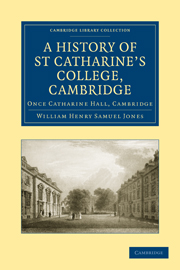Book contents
- Frontmatter
- Contents
- ERRATA
- ILLUSTRATIONS
- Preface
- Epochs and List of Master
- Part I THE HISTORY
- Part II MATERIALS
- Chapter I Authorities
- Chapter II Letters
- Chapter III Statutes
- Chapter IV The Library
- Chapter V Estates and Income
- Chapter VI Agricultural property
- Index of chief subjects
- Index of Names
- Plate section
Chapter VI - Agricultural property
Published online by Cambridge University Press: 05 June 2011
- Frontmatter
- Contents
- ERRATA
- ILLUSTRATIONS
- Preface
- Epochs and List of Master
- Part I THE HISTORY
- Part II MATERIALS
- Chapter I Authorities
- Chapter II Letters
- Chapter III Statutes
- Chapter IV The Library
- Chapter V Estates and Income
- Chapter VI Agricultural property
- Index of chief subjects
- Index of Names
- Plate section
Summary
DOCUMENT DRAWN UP BY THE BURSAR IN 1922
Before the days of national and municipal borrowing practically no form of investment was open to the College except land and houses. Most benefactions consisted of land or tenements, and in the few cases where a gift of money was made, it was usually invested at once in estate. The disadvantages of the system, especially in the case of distant property, are obvious; the advantages are less easily recognised. But the necessity of managing estates doubtless prevented the Society being wholly unacquainted with business; the memory of donors was kept alive; above all, the value of land was far more stable than the value of money.
In the nineteenth century, while considerable portions of income, and new benefactions, were put into stocks, few of the old estates were sold, chiefly because of the conservatism of collegiate corporations. But the enhanced value of agricultural land during the war of 1914–1918, the increased burdens laid upon landlords, and the high rates of interest to be obtained from investments, induced St Catharine's to sell nearly all its purely agricultural property, and to retain only land valuable as potential building sites or for the minerals beneath the surface.
- Type
- Chapter
- Information
- A History of St Catharine’s College, CambridgeOnce Catharine Hall, Cambridge, pp. 401 - 404Publisher: Cambridge University PressPrint publication year: 2010First published in: 1936



